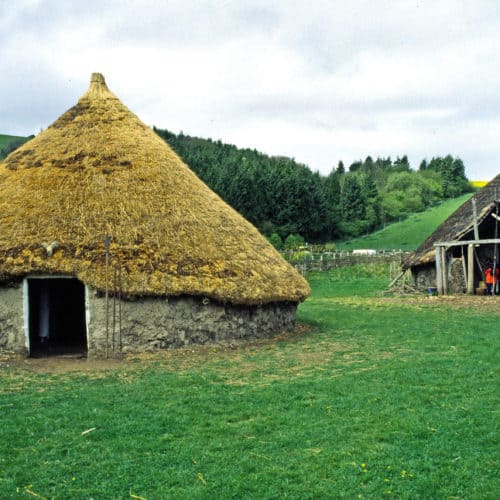Stone Age to Iron Age activity 5: build a prehistoric roundhouse
Archaeological evidence from Bronze Age settlements on the Kent Downs, and the Iron Age settlement on Folkestone’s East Cliff, indicates that prehistoric people were living in roundhouses in the Folkestone area.
Find out all about these incredible structures and have a go at making your own in 10 easy steps.
Image copyright: Canterbury Archaeological Trust
Learning objectives
Increased knowledge and understanding of Bronze Age and Iron Age communities in the Folkestone area and the houses they lived in.
Research skills.
Design technology skills.
Curriculum links
KS1-2 History (Bronze Age and Iron Age homes).
KS1-2 Design technology (build a model roundhouse)
Start with Learn with Objects Stone Age to Iron Age 4: round house. Look at the photo showing the curved ditch in the ground uncovered by archaeologists beneath the Folkestone Roman Villa site.
Tell the children that when archaeologists were excavating the site of Folkestone Roman Villa between 2010 and 2013, they discovered an interesting feature, that ran beneath the Roman Villa wall.
Ask the class the following questions:
- What hollow shape can you see in the ground just in front of the wall of Folkestone Roman Villa?
(a curve) - If you extended it, what would the complete shape be?
(round) - Roughly how big is it?
(the red and white pole is 1 metre long, so about 10 metres across) - The Roman Villa is built on top of it: what does this tell us about the date of this feature?
(It was built before the Romans built the villa). - What do you think it is?
(It’s the ditch of an Iron Age roundhouse).
It’s just one of many important pieces of archaeological evidence that there was an Iron Age site on Folkestone’s East Cliff, before the arrival of the Romans and the building of the villa.
Ask the children to explore Learn with Objects Stone Age to Iron Age 2, 3, 4, 5, 6, 7 and 15 to find further evidence of Iron Age occupation of the site, including evidence of another roundhouse.
They can also use books and other websites to research more widely about Iron Age roundhouses, thinking about the following questions:
- How were they built?
- What materials did they use?
- What is wattle and daub?
- How were they heated, lit and furnished?
- Where did people cook, eat and sleep?
Here’s some good background info on daily life in prehistoric Britain.
https://www.english-heritage.org.uk/learn/story-of-england/prehistory/daily-life/
Watch this simple animation showing how a roundhouse was built.
http://www.canterburytrust.co.uk/learning/resources/how-did-they-build-a-prehistoric-round-house/
There is great content here for teachers in these schemes of work inspired by the Dover Bronze Age Boat and Bronze Age discoveries at Thanet Earth.
http://www.canterburytrust.co.uk/schools/pdf/section4_scheme_of_works.pdf
Explore this great resource from English Heritage on Prehistoric food and feasting in Britain. Including a cutaway roundhouse you can look inside.
Much more detailed, for simplification by a teacher, but here’s some fascinating evidence for Early Bronze Age occupation in Holywell Coombe, on the edge of Folkestone where post holes, a hollow trackway and lots of pottery sherds indicate the location of a small settlement. The black and white photo Plate 1 on page 9 clearly shows the trackway and postholes. https://www.kentarchaeology.org.uk/sites/default/files/archcant/1989%20106%20Archaeology%20and%20The%20Channel%20Tunnel%20Bennett.pdf
Make an model roundhouse
Make a roundhouse in ten easy steps, using this excellent resource from English Heritage.
Or there’s this one from the Young Archaeologist’s Club
https://www.yac-uk.org/userfiles/file/1429016036_Iron_Age_Roundhouse.pdf

